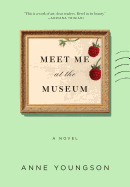
What does one's life look like on paper? In hindsight? Through the eyes of a dear friend? These are the questions at the heart of Anne Youngson's wonderful epistolary novel, Meet Me at the Museum. It begins with a tragedy: Tina, a middle-aged farmer's wife living in rural England, loses her lifelong best friend, Bella, to cancer. When Bella dies, so does Tina's dream to travel to Denmark to see the "Tollund Man," human remains from the Iron Age on view at a museum there. The anthropologist who discovered the remains visited Tina and Bella's school when they were children, and the Tollund Man became something of a mythic figure for the pair; to embark on a trip together to see him would be something like a joint religious pilgrimage.
But without Bella, Tina cannot bring herself to make the journey. To discover why she feels this way, she writes a letter to the museum's curator. Doing so is an exercise in self-discovery--a kind of psychological self-analysis--and she doesn't expect a response. But she receives one.
Anders replies to her missive because he can't help but correct some of the facts she gets wrong--he is at heart, after all, a museum curator obsessed with factual precision. But he doesn't write with hostility. On the contrary, he's intrigued by Tina's perspective on the Tollund Man and her vibrant word choice throughout her letter (his first language is Danish, not English). Thus begins a correspondence that lasts more than a year.
This novel, Youngson's first, is structured entirely by their correspondence. With each letter, we learn more about Tina and Anders--about their families, their interests, their uncertainties about life. We watch as their intimacy grows and, along with it, a shared openness about what they regret most about their pasts and what they hope for the future. This is the rare novel that explores the nuances of adult relationships with clear-eyed insight.
Their relationship can't be entirely categorized as either romance or friendship. That's the other question at heart here: Just how do they feel about each other? A detailed answer would spoil the novel's ending, but it's safe to say that what develops between them is at once beautiful, innocent and dangerous--it just depends on how one looks at their relationship, and who's doing the looking. The peripheral characters--Tina's husband, Anders's children--are present in most of the letters, but their views on the relationship are revealed slowly, in pace with the protagonists' self-revelations about how they feel.
What makes this novel truly sing is Youngson's talent for writing highly individualized characters. From Tina we get expressive and well-written letters representative of a woman who's spent a lifetime reading but who has relied mostly on her imagination to travel the world. From Anders we get a perspective that befits a museum curator who is accustomed to travel, cultural experiences and life in a city. Yet there's nothing stereotypical about either correspondent. They transcend their status and cultural backgrounds by revealing surprising thoughts and complex opinions--indeed, their mutual sensitivity to the world and to each other's feelings is, at least in part, what makes each of them interested in the other.
This novel is also about the evolution of families. As they muse about their children's successes and failures--and delight in the birth of grandchildren--Tina and Anders's letters become investigations of generational differences and proper parenting techniques. We learn that despite their best intentions, both live with lots of uncertainty about whether they made the right choices regarding their kids. And now that their children are grown, they hesitate to offer advice for fear of steering them in wrong directions. In these moments, the novel is perhaps at its most poignant.
The two also discuss their regrets about marriage. Anders's wife, we learn, suffered greatly from mental illness and died a mere 18 months before his correspondence with Tina begins. He is still reeling from the loss. Tina married young--she became pregnant out of wedlock and was guilted by her family into marrying the baby's father. Her life ever since has been one of sacrifice, she writes to Anders. Neither letter writer ever comes across as overly sentimental, however--Youngson has given us two compassionate psychologies that feel as if they belong to real people.
By the book's end, Tina and Anders's reflective letters reveal a relationship built on a shared feeling of disbelief at having reached middle age. It's not the aging itself that troubles them--both are quick to explain to the other that they have remained in good health. But both are questioning for the first time some of their life's biggest decisions. It's only in writing to each other that they come to truly understand their pasts, and they're not entirely happy with what they discover about themselves. Beautifully written and deeply moving, Meet Me at the Museum is a superb--and tenderhearted--debut that will interest anyone who's ever questioned how they became the person they are today. --Amy Brady

